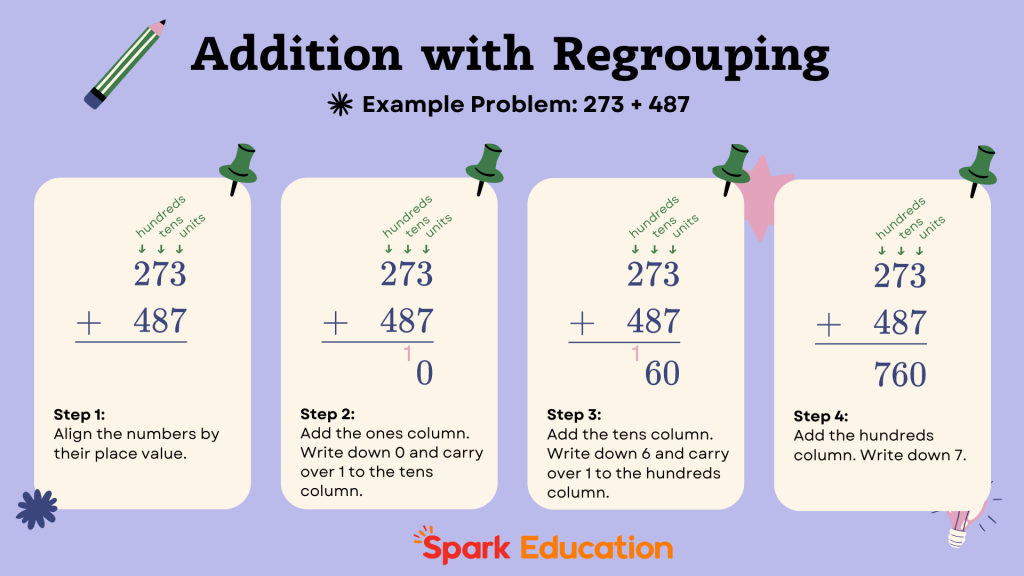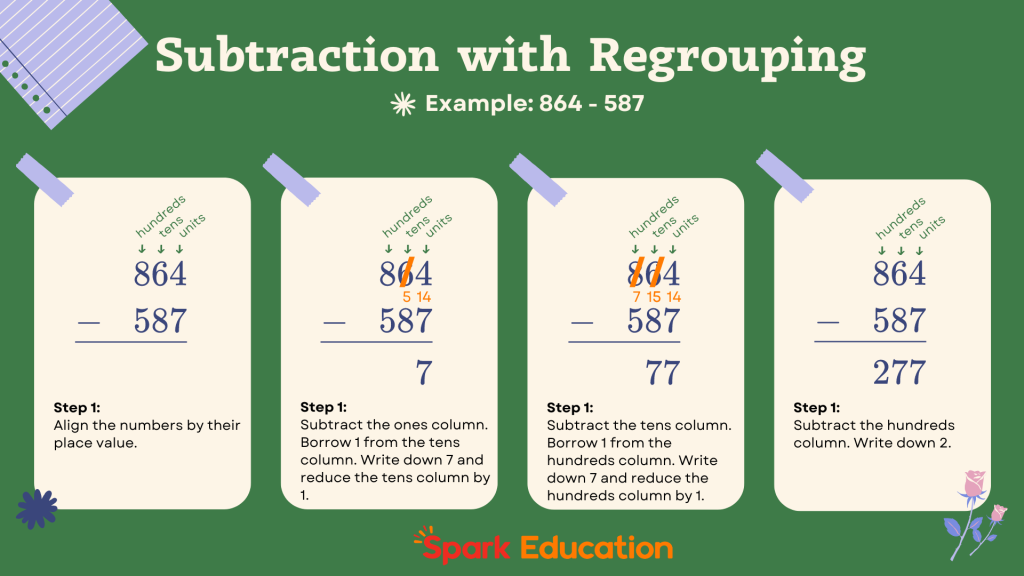Welcome, math enthusiasts! Today, we’re diving into the essential arithmetic skills of addition and subtraction with regrouping. These techniques are crucial for building a solid mathematical foundation and are immensely useful in both academic settings and everyday life. Whether you’re a student looking to understand the concept better or a parent helping your child with homework, this blog will guide you through the intricacies of regrouping and how to master it.
What is Addition and Subtraction with Regrouping?
Let’s start by revisiting place value, as it’s a crucial concept for us to understand before we can confidently grasp regrouping. Place value is the value of a digit in a number based on its position. For instance, in the number 350, the 5 holds a place value of 5 tens, or 50, whereas in the number 5006, the 5 holds a place value of 5 thousands, or 5000.
Regrouping, also known as carrying in addition and borrowing in subtraction, is a technique used when the numbers you’re working with are too big or too small to fit neatly into a single column. It’s like rearranging your toys when you have too many for one shelf!
Example:
- In addition, regrouping involves carrying over a value to the next column when the sum exceeds the base value (usually 10). Consider 27 + 58. The sum of 7 and 8 is 15, which requires us to carry over 1 to the next column. So, we regroup to add (7 + 8 = 15, write down 5, carry over 1).
- In subtraction, regrouping involves borrowing from the next column when the number is not sufficient to subtract. Look at 52 – 28. Since 2 is smaller than 8, we borrow 1 from the next column, making it 12 – 8 (12 – 8 = 4, reduce the next digit).
Steps to Regrouping in Addition and Subtraction
Addition with Regrouping
Imagine you have a bunch of apples and want to add more. Sometimes, you end up with more than ten apples in one group, and you need to make a new group. This is where regrouping comes in!
Let’s understand the process of addition with regrouping with a step-by-step example.
Example Problem: 273 + 487
Step-by-Step Guide
- Align the Numbers: Start by writing the numbers one below the other, aligning them by place value (units, tens, hundreds, etc.).
- Start from the Rightmost Digit: Begin adding from the rightmost digit (units). If the sum is greater than 9, write the unit digit and carry the tens digit over to the next column.
Add the digits in the ones column (3 + 7 = 10). Write down 0 and carry over 1 to the tens column.
- Add the Next Column: Move to the next column and add the digits, including any carried-over value.
Add the digits in the tens column along with the carry-over (7 + 8 + 1 = 16). Write down 6 and carry over 1 to the hundreds column.
- Continue Until All Columns are Added: Repeat the process for each column, moving left.
Add the digits in the hundreds column along with the carry-over (2 + 4 + 1 = 7). Write down 7.

The final answer is 760.
Subtraction with Regrouping
Now, let’s think about having a cookie jar with some cookies. If you eat more cookies than what’s in the jar, you’ll need to borrow from another jar. This is what we do in subtraction with regrouping!
Let’s explore subtraction with regrouping also through an example.
Example Problem:
Step-by-Step Guide
- Align the Numbers: Write the numbers with the smaller number below the larger, aligning by place value.
- Start from the Rightmost Digit: Begin subtracting from the rightmost digit (units). If the top digit is smaller than the bottom digit, borrow from the next column.
Since 4 is smaller than 7, borrow 1 from the tens column. This makes the ones column 14 (14 – 7 = 7). Reduce the tens column by 1.
- Borrowing Process: If borrowing is needed, reduce the next left column by one and add ten to the current column.
Now, 5 (originally 6 before borrowing) is smaller than 8, borrow 1 from the hundreds column. This makes the tens column 15 (15 – 8 = 7). Reduce the hundreds column by 1.
- Continue Until All Columns are Subtracted: Repeat for each column, moving left.
Finally, subtract the hundreds column after borrowing. (7 – 5 = 2).

The final answer is 277.
Mixed Addition and Subtraction with Regrouping
When faced with problems that involve both addition and subtraction with regrouping, it’s important to approach each operation step by step. Ensure that the numbers are aligned correctly and regroup when necessary.
Example: Solve 123 + 456 − 78
- First, perform the addition:
- Units: 3 + 6 = 9
- Tens: 2 + 5 = 7
- Hundreds: 1 + 4 = 5
- Result: 123 + 456 = 579
- Next, perform the subtraction:
- Units: 9 − 8 = 1
- Tens: 7 − 7 = 0
- Hundreds: 5 − 0 = 5
- Result: 579 − 78 = 501
The final answer is 501.
Common Mistakes and How to Avoid Them:
Misalignment of Numbers:
- Ensure that each digit is in the correct column (units under units, tens under tens, etc.). Misalignment can lead to incorrect calculations.
Forgetting to Regroup:
- Always check if the sum exceeds 9 in addition or if borrowing is needed in subtraction. Skipping regrouping can result in errors.
Incorrect Carrying/Borrowing:
- Double-check your carried or borrowed values. Mistakes in these steps can throw off the entire calculation.
Addition and Subtraction with Regrouping Worksheets
Worksheets are a great way to practice these skills. Look for exercises that gradually increase in complexity, starting with two-digit numbers and progressing to three-digit numbers and beyond.
Conclusion
Mastering addition and subtraction with regrouping is a crucial skill that supports numerous mathematical concepts and everyday activities. By understanding the steps, avoiding common mistakes, and consistently practicing, you can develop strong and precise arithmetic skills.
Interested in taking your child’s math skills to the next level? Sign up for a FREE trial class with Spark Math by Spark Education today or try our FREE Online Math Assessment for a detailed report on your child’s math skills! Spark Math is the flagship math course under Spark Education, offering small group classes taught by experienced and engaging real-life teachers. Our program is designed to ignite your child’s passion for learning math, providing a rich array of math resources and an immersive learning experience. Come and see how Spark Math can make a difference in your child’s education!




